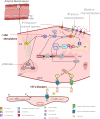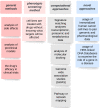Drug repurposing-a promising approach for patients with angina but non-obstructive coronary artery disease (ANOCA)
- PMID: 37396593
- PMCID: PMC10313125
- DOI: 10.3389/fcvm.2023.1156456
Drug repurposing-a promising approach for patients with angina but non-obstructive coronary artery disease (ANOCA)
Abstract
In today's era of individualized precision medicine drug repurposing represents a promising approach to offer patients fast access to novel treatments. Apart from drug repurposing in cancer treatments, cardiovascular pharmacology is another attractive field for this approach. Patients with angina pectoris without obstructive coronary artery disease (ANOCA) report refractory angina despite standard medications in up to 40% of cases. Drug repurposing also appears to be an auspicious option for this indication. From a pathophysiological point of view ANOCA patients frequently suffer from vasomotor disorders such as coronary spasm and/or impaired microvascular vasodilatation. Consequently, we carefully screened the literature and identified two potential therapeutic targets: the blockade of the endothelin-1 (ET-1) receptor and the stimulation of soluble guanylate cyclase (sGC). Genetically increased endothelin expression results in elevated levels of ET-1, justifying ET-1 receptor blockers as drug candidates to treat coronary spasm. sGC stimulators may be beneficial as they stimulate the NO-sGC-cGMP pathway leading to GMP-mediated vasodilatation.
Keywords: ANOCA; ET-1 receptor blockers; drug repurposing; refractory angina; sGC stimulators.
© 2023 McChord, Pereyra, Froebel, Bekeredjian, Schwab and Ong.
Conflict of interest statement
MS has received research grants outside the submitted work from Green Cross WellBeing Co. Ltd, Gilead Sciences Inc., Agena Bioscience GmbH, Corat Therapeutics GmbH, CED Service GmbH, and from the Robert Bosch GmbH, and has received honoraria for oral presentations at academically organized congresses and meetings. MS is in part supported by the Robert Bosch Stiftung, Stuttgart, Germany. The remaining authors declare that the research was conducted in the absence of any commercial or financial relationships that could be construed as a potential conflict of interest
Figures
Similar articles
-
Bridging the Gender Gap in Cardiovascular Medicine: Addressing Drug Intolerances and Personalized Care for Women with Angina/Ischemia with Non-Obstructive Coronary Artery Disease.J Cardiovasc Dev Dis. 2024 Nov 28;11(12):381. doi: 10.3390/jcdd11120381. J Cardiovasc Dev Dis. 2024. PMID: 39728271 Free PMC article. Review.
-
INOCA/ANOCA: Mechanisms and novel treatments.Am Heart J Plus. 2023 Jun;30:100302. doi: 10.1016/j.ahjo.2023.100302. Epub 2023 May 12. Am Heart J Plus. 2023. PMID: 37377840 Free PMC article.
-
Vasomotor dysfunction in patients with angina and nonobstructive coronary artery disease is dominated by vasospasm.Int J Cardiol. 2021 Jun 15;333:14-20. doi: 10.1016/j.ijcard.2021.02.079. Epub 2021 Mar 10. Int J Cardiol. 2021. PMID: 33711394
-
Angina and Non-Obstructive Coronary Artery (ANOCA) Patients with Coronary Vasomotor Disorders.Life (Basel). 2023 Nov 10;13(11):2190. doi: 10.3390/life13112190. Life (Basel). 2023. PMID: 38004330 Free PMC article.
-
Update on coronary artery spasm 2022 - A narrative review.Int J Cardiol. 2022 Jul 15;359:1-6. doi: 10.1016/j.ijcard.2022.04.011. Epub 2022 Apr 14. Int J Cardiol. 2022. PMID: 35429510 Review.
Cited by
-
Bridging the Gender Gap in Cardiovascular Medicine: Addressing Drug Intolerances and Personalized Care for Women with Angina/Ischemia with Non-Obstructive Coronary Artery Disease.J Cardiovasc Dev Dis. 2024 Nov 28;11(12):381. doi: 10.3390/jcdd11120381. J Cardiovasc Dev Dis. 2024. PMID: 39728271 Free PMC article. Review.
References
Publication types
LinkOut - more resources
Full Text Sources



